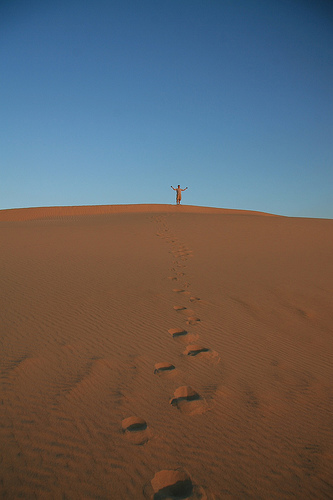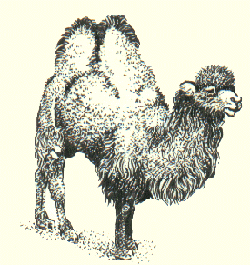What is a Desert?
 When you hear the word 'desert', what picture does it bring to mind? Perhaps you think of a very dry place, a place without people or plants living there. In fact, a deserted place. Perhaps you also think of miles and miles of sand dunes, and a scorching sun burning down from a cloudless sky.
When you hear the word 'desert', what picture does it bring to mind? Perhaps you think of a very dry place, a place without people or plants living there. In fact, a deserted place. Perhaps you also think of miles and miles of sand dunes, and a scorching sun burning down from a cloudless sky.
One fifth of the world's land surface is desert. A desert is technically defined as an area which has on average less than 250mm of rain per year. However, annual rainfall could be as low as 20mm, leading to periods of intense dryness which often last for several years followed by periods of heavy rainfall and flooding. Surprisingly, more people die in deserts each year from drowning than from thirst.
One of the most famous deserts, the Sahara in North Africa, is very hot and very dry. The Sahara is one of the hottest place on Earth, with a maximum recorded temperature of 58 C in the shade. Yet at night the desert becomes very cold, with temperatures often falling below freezing.
The Danakil Depression in Ethiopia holds the record for the highest average annual temperatures. 35C (95F) is the average temperature for the whole year here! There is no shade, just the unremitting heat of the sun. The picture here is of Algodones Dunes, a desert area in California, America.
Some deserts in Asia such as the Gobi desert are very cold for most of the year. Reports from a weather station at Ulaanbaatar in the middle of the Gobi desert show that for more than six months of the year, the temperature does not rise above freezing whilst during the winter months temperature regularly drops to below - 20C. Rainfall here is on average 194mm per year.
 There are four types of desert landscape. The first, and our most common vision of what a desert should look like, is the sand desert or erg. About one third of all desert landscapes are like this. The sand is blown into hills or dunes by the wind. These shift over time so that if the movements of the dunes of a sand desert over several years were filmed and then speeded up so that the film lasted only a few minutes, the movements of the desert would look like ripples in the water. It is for this reason that ergs are sometimes called "sand seas".
There are four types of desert landscape. The first, and our most common vision of what a desert should look like, is the sand desert or erg. About one third of all desert landscapes are like this. The sand is blown into hills or dunes by the wind. These shift over time so that if the movements of the dunes of a sand desert over several years were filmed and then speeded up so that the film lasted only a few minutes, the movements of the desert would look like ripples in the water. It is for this reason that ergs are sometimes called "sand seas".
The dunes may shift only very slowly, but they will over long periods of time bury anything in their path, including houses, villages or crops. For this reason, if people wish to grow any crops in deserts, the dunes have to be "fixed" in place. This is done by planting grasses with very long roots which reach deep into the sand and help to hold the dunes together, preventing the wind from blowing them away.
Find out about the other desert landscapes...
